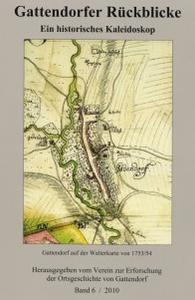|
The
|
||||||
THE BURGENLAND BUNCH NEWS - No. 209 April 30, 2011, © 2011 by The Burgenland Bunch All rights reserved. Permission to copy excerpts granted if credit is provided. Our 15th Year, Interim Editor: Thomas Steichen The Burgenland Bunch Newsletter is issued monthly online. It was founded by Gerald Berghold (who retired in Summer 2008 and died in August 2008). |
||||||
Current Status Of The BB: * Members: 1934 * Surname Entries: 6648 * Query Board Entries: 4571 * Number of Staff Members: 17 |
||||||
This newsletter concerns: 1) THE PRESIDENT'S CORNER 2) NEUSIEDLER SEE (by Matt Boisen) 3) HEIDEBODEN - WHERE AND WHAT WAS IT? 4) HUNGARIAN CITIZENSHIP 5) ORPHANAGE NEAR KUKMIRN? 6) GOOGLE TRANSLATE 7) JEWISH LAWYERS IN BURGENLAND, 1938 8) THE OLD FARMHOUSES OF BURGENLAND 9) MEMBER RESEARCH: SEARCHING FOR "HOME" 10) HISTORICAL BB NEWSLETTER ARTICLES: DISTRICTS OF VIENNA (FORMERLY VILLAGES) 11) ETHNIC EVENTS (courtesy of Bob Strauch & Margaret Kaiser) 12) BURGENLAND EMIGRANT OBITUARIES (courtesy of Bob Strauch) |
||||||
1) THE PRESIDENT'S CORNER (by Tom Steichen)  This
month finds us mostly in the northern Neusiedl district of Burgenland and, even further
north, in Vienna. In Articles 2, Contributing Writer Matt Boisen takes us on a history trip
around and through the Neusiedler See and the associated Hanság swamplands region, both being
key to the tourism that has brought economic success to the area. Article 3 speaks of the
neighboring Heideboden region, defining what it was and which villages were part of it.
Article 10, our Historical BB Article from 2001, defines the districts of Vienna and the names
associated with them over time. Lastly, Article 7 speaks about two books, one on Jewish
Lawyers in Burgenland and Vienna (and Lower Austria too); the other on Gattendorf, a village
in the Heideboden region. This
month finds us mostly in the northern Neusiedl district of Burgenland and, even further
north, in Vienna. In Articles 2, Contributing Writer Matt Boisen takes us on a history trip
around and through the Neusiedler See and the associated Hanság swamplands region, both being
key to the tourism that has brought economic success to the area. Article 3 speaks of the
neighboring Heideboden region, defining what it was and which villages were part of it.
Article 10, our Historical BB Article from 2001, defines the districts of Vienna and the names
associated with them over time. Lastly, Article 7 speaks about two books, one on Jewish
Lawyers in Burgenland and Vienna (and Lower Austria too); the other on Gattendorf, a village
in the Heideboden region.We do, though, have a couple of articles on member research efforts that takes us south. Dan Richman asks, in Article 5, about an orphanage near Kukmirn (no such thing though) in the Güssing district and, in Article 9, we help point Joyce Ward at some Hungarian villages on Güssing's southern border for her Tomasits family. Unfortunately, we were not able to help Ed Silver track down the Silver family home village. On other fronts, Article 4 provides information about recent changes in the rules and procedures for obtaining Hungarian citizenship. While I'm sure that is not a primary goal for most of us, it still may be of interest to you. Article 6 delves into the workings of Google Translate... and some thoughts on where that technology may be going. And Article 8, on the types of Burgenland farmstead houses, provides a little exposé on what is behind the front walls of the older sections of many villages. We, of course, also present the Ethnic Events calendar and the Emigrant Obituary sections. The Mexican Funeral Around 10 years ago, I attended a Mexican funeral at the famous old San Fernando Cathedral in San Antonio, Texas. The priest offered the following story:
Several years later, I got into genealogy and realized that persons who preserve the
memories of persons from their own familial past are preventing that third death. |
||||||
2) NEUSIEDLER SEE (by Matt Boisen) “Few natural phenomena have intrigued European geographers as much as has Lake Neusiedl.” - Andrew F. Burghardt 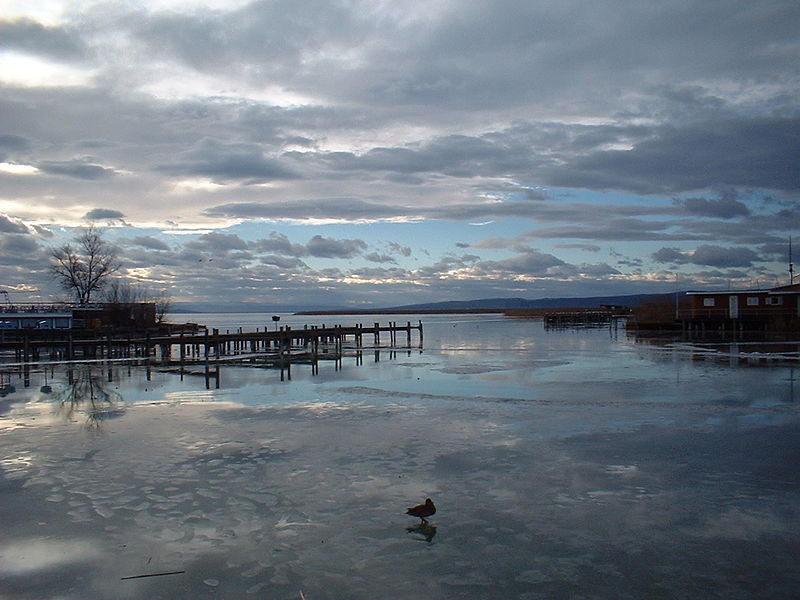 Neusiedler See - Blick von Neusiedl nach Süden 3 Jan 2003 © Lutz Fischer-Lamprecht [used under the Attribution-Share Alike 3.0 Unported license] Wind, ice, rain, lowlands, and more wind. These are the factors that define the second largest steppe lake in central Europe, Lake Neusiedl (“German: Neusiedlersee, “New Settler’s Lake” or Hungarian: Ferto tó, “Swampy Lake”). Lying on the surface of the Kisalföld, the flat basin south of the Leitha Range, the lake covers 315 km² (195 sq. miles), roughly the size of Lake Tahoe. It is about 35 km (22 mi.) from north to south and varies in width from 6 to 12 km (3.7 to 7.5 mi). Unlike 166-fathom-deep Lake Tahoe, however, nowhere is the Neusiedler See more than 1 fathom deep (1 fathom = 6 feet). Because it lies on the surface, the lake fluctuates in size due to rainfall, evaporation and wind. Only one small stream, the Wulka, feeds into it. Strong northerly winds have pushed water to flood the southern reed beds, while the northern lake bed dried up. Geological evidence indicates that the lake has dried up completely at least 100 times in the past. Channels were dug in the 1700s, which allowed some drainage and the establishment of meadows, but the lake returned, inundating the area by 1838. In 1866, the last time the lake bed dried out, there was interest in keeping it drained for agriculture, but nothing came of it due to the salinity and marginal fertility of the soil. In any event, the lake again assumed its normal size ten years later. Each time the lake dried up, there were notable changes in the surrounding environment, due to the loss of the humidifying effect of the lake, and wind-blown salt and dust blasted nearby villages until the lake returned. The Imperial Navy operated a sailing class for cadets on the Neusiedlersee for a short time, but the fluctuating water levels often left the boats high and dry, so the school was closed. The early 1900s saw the completion of the Einser Canal, linking the lake with the Danube watershed to the southeast. Drainage was difficult, and the river sometimes backed into the lake, requiring constant dredging. Further projects ceased after the First World War due to the imposition of the international border and pressure from hunters, conservationists and villagers fearful of what the loss of the lake would do to the local lifestyle and climate. In 1936, the lake was only 16 inches deep, and the water temperature recorded at 93°F but, by 1941, the lake reached its largest expansion in forty years, flooding surrounding villages. Today, the Einser Canal and a sluice on the Hungarian side control the water depth and salinity, which enabled the reed beds to expand. To the southeast are the marshy areas known as Hanság (German: Waasen), much of which was drained for agriculture by the 1950s. North of the lake lies the Parndorfer Heide, a dry, windswept wine growing area that was one of the last areas to come under the plow. Villages in the Heide are tucked under the south-facing slopes to escape the fierce winds. Denizens of this steppe-like area were known as Heidebauern (“heath peasants”). 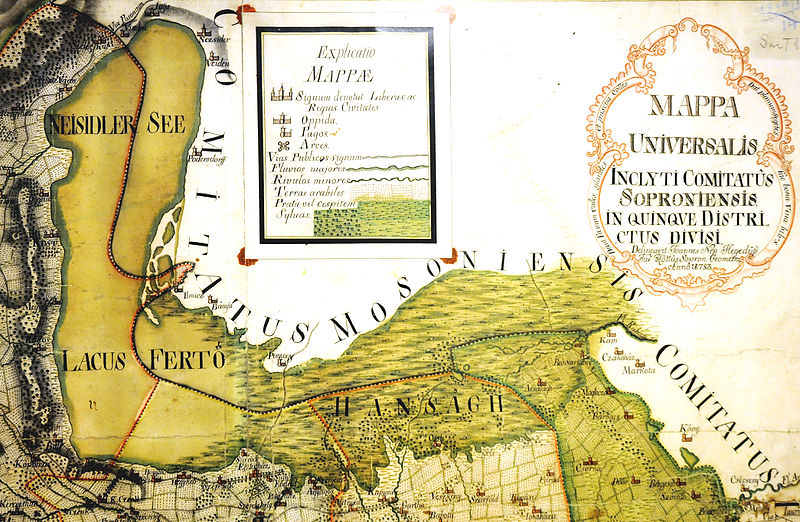 1783 map by Johannes Hegedüs (public domain) showing Lake Neusiedl contiguous with the extensive Hanság swamp extending eastward from the southern end of the lake Town sites have been known around the Neusiedlersee for thousands of years. Celts (Boii) of the Halstatt culture were followed by the Romans as they established the province of Pannonia. Roman villas and a temple of Mithras have been excavated near Fertõrákos. It was during Roman times that the famed Amber Road was established, skirting the western shore of the Neusiedlersee. At the same time, the first vineyards were planted. Waves of migration and invasion swept over the land, including Huns, Ostrogoths, Avars, Franks, Magyars, Mongolians and Turks. In times of trouble, the locals were known to have hidden in the reed beds or took to the hills of the Leitha Range. In the marshy Hanság, villages were built on hillocks called “goronds.” The Turkish invasions in the 1500s and 1600s and the Hungarian revolts (Kuruzzenkrieg, a corruption of the Hungarian “kuruczok” from the Latin Cruciati: “bearers of the Cross,” a patriotic Hungarian brotherhood) also devastated the area, with the inhabitants again fleeing into the reeds or the surrounding hills until the trouble subsided in 1711. The Croats made their first appearance in the area following these events. The Germans proved the most persistent, settling and resettling after each upheaval, giving the name “Neusiedl” (New Settlement) to the area and the lake. Remains of habitation on the lakebed itself go back to Neolithic times. Predictably, however, the lake would return. Over the years, “lost villages” became part of the local lore. A legend tells of the murder of a girl by the Lord of Forchtenstein. In revenge, her mother called heaven down upon his head. Overnight, water filled the basin, carrying the girl’s body to shore, where the penitent Lord built a shrine called Frauenkirchen. The villagers fled to higher ground, founding the village of Neusiedl am See. Hauftal, Schwarzlacken, Königstal, See and St. Jakob were five villages known to be lost forever due to rising water levels of the lake. Important Austrian towns surrounding the lake include Podersdorf am See, Illmitz, Apetlon (which form the Seewinkel or “lake corner” on the eastern shore), Neusiedl am See, Breitenbrunn, Purbach am Neusiedlersee, Rust and Mörbisch. Only Podersdorf is considered to be reed-free, and hence has proven popular with Viennese holiday-makers. In Hungary, the best known villages include those that voted in the 1921 plebiscite to remain in Hungary: Fertorákos, Fertoboz, Fertod, Balf and Fertoújlak. 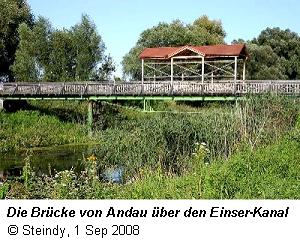 As
an otherwise literal backwater, the aforementioned Seewinkel gained international fame for a
short period in 1956 when refugees streamed over the modest Andau Bridge into Austria across
the Einser Canal during the Soviet crackdown of the Hungarian revolt. As
an otherwise literal backwater, the aforementioned Seewinkel gained international fame for a
short period in 1956 when refugees streamed over the modest Andau Bridge into Austria across
the Einser Canal during the Soviet crackdown of the Hungarian revolt. A bridge of larger proportions was considered in the 1960s to link the Seewinkel with the western shore, but plans were dropped due to environmental concerns. The Andau bridge again made news in 1989 when East Germans sought freedom following the collapse of Communism. In 2001, the Seewinkel area was declared a UNESCO World Cultural Heritage Site. Economic use of the area includes tree farming, cattle grazing (Hungarian grey cattle and water buffalo), hunting, fisheries, tourism and the use of the reed beds. The vast reed beds are utilized in insulation, thatching and other construction 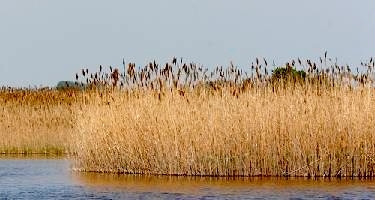 purposes.
There is talk of a biomass power plant that would use reeds for fuel. The reeds are also
critical as a haven for wildlife, attracting the famous storks of Rust and other water birds
to the area. Other flora and fauna, such as the endangered great bustard, frogs, tarantulas
and rare orchids attract attention, making the surrounding villages a mecca for eco-tourism. purposes.
There is talk of a biomass power plant that would use reeds for fuel. The reeds are also
critical as a haven for wildlife, attracting the famous storks of Rust and other water birds
to the area. Other flora and fauna, such as the endangered great bustard, frogs, tarantulas
and rare orchids attract attention, making the surrounding villages a mecca for eco-tourism.Many city folk flock to this “Sea of the Viennese” on weekends to drink the local wine, enjoy the sparkling lake and the dry, mild puszta-like climate (annual rainfall: 23 inches, average sunny days: 300). Lakeside vacation homes and tourist parks abound on both sides of the lake. There are yearly festivals and sports competitions, including the “Seedurchquerung” a walk/swim across the lake from Mörbisch to Illmitz. In 2006, the Neusiedlersee hosted the world windsurfing and sailing championships. The Hanság, however, stagnated during depression, war and the Communist era. The population dropped as collective farming intensified and the marshes were drained. People no longer saw value in land they could not own, and made no moves to protect it. After the fall of Communism, the former wetlands of the Hanság recovered somewhat, helped in part by the return of private enterprise and the formation of the Neusiedlersee-Seewinkel (Austria) and Fertö–Hanság (Hungary) National Parks in the 1990s. In summary, the story of the Neusiedlersee is one of ebb and flow. The lake and the surrounding area became a crossroads of history as invaders, empires and ideologies struggled. Borders shifted back and forth and the lake itself fluctuated in response to its natural environment. Various peoples settled, were chased away and returned. The Neusiedlersee and its lakeside villages, along with the neighboring Heideboden and Hanság, 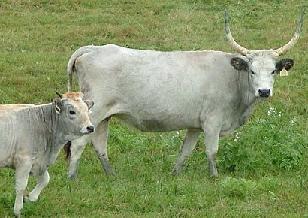 have
cultural, economic and natural preservation value. These need not be competing or mutually
exclusive interests. The lake and marshes need not be drained. The “heirloom” Hungarian grey
cattle may graze in the National Parks. Vineyards thrive in the dry heat. Trees may be planted
in areas that were left fallow due to poor agricultural practices. Sustainable harvesting of
reeds can be done, and biologists and conservationists will continue to study endangered great
bustards, orchids and the complex ecosystem that makes up the reed beds. Birdwatchers still
welcome the waterfowl that return each year. Hikers delight in finding remains of “goronds”
deep in the marshes. Tourists still enjoy water sports and contribute to the economic
well-being of lakeside towns. Along with concerns that the Neusiedlersee will dry up
permanently in the next fifty years due to global warming, balancing these needs will result
in the preservation of the area for generations to come. have
cultural, economic and natural preservation value. These need not be competing or mutually
exclusive interests. The lake and marshes need not be drained. The “heirloom” Hungarian grey
cattle may graze in the National Parks. Vineyards thrive in the dry heat. Trees may be planted
in areas that were left fallow due to poor agricultural practices. Sustainable harvesting of
reeds can be done, and biologists and conservationists will continue to study endangered great
bustards, orchids and the complex ecosystem that makes up the reed beds. Birdwatchers still
welcome the waterfowl that return each year. Hikers delight in finding remains of “goronds”
deep in the marshes. Tourists still enjoy water sports and contribute to the economic
well-being of lakeside towns. Along with concerns that the Neusiedlersee will dry up
permanently in the next fifty years due to global warming, balancing these needs will result
in the preservation of the area for generations to come. |
||||||
3) HEIDEBODEN - WHERE AND WHAT WAS IT? Last month, in the article on the resettlement of West Hungary, post-1700, I made numerous references to an area called the Heideboden, and indicated that it was associated with the Neusiedl district. When the BB staff reviewed a draft of that article, a question was raised on whether that term, Heideboden, would be better than Burgenland, or even West Hungary, in representing the whole region of interest. After all, there was no placed named "Burgenland" in the sixteen- and seventeen-hundreds and it wasn't really clear what the limits of "West Hungary" were. My response was:
Later, after the above message was sent and the article completed, I wondered if I could
come up with a more accurate mapping of the Heideboden and document the villages that would
have been within it. I first scoured the web in search of a definitive definition of the
Heideboden, a map of it, and a list of the villages it contained. Simply put, I largely struck
out! On the map, you can also see where the Hanság and Seewinkel are marked, as well as another
region near the Danube called the Klein-Schutt (which I was not previously aware of).
Two Neusiedl villages, Pamhagen and Wallern, are near the southern edge of my Heideboden
region... but seem to belong better into Hanság and/or Seewinkel. In addition, I could find
nothing to suggest that Gols, Mönchhof and Halbturn were ever considered Heideboden
villages... but they are below the Parndorfer Plateau so seem to belong. If we include them in
Heideboden, there are 27 villages that were in the Heideboden region; if not included, only
24. |
||||||
4) HUNGARIAN CITIZENSHIP Margaret Kaiser recently pointed out an article (in the central Connecticut online newspaper, www.MyRecordJournal.com) concerning the easing of the language requirement for Hungarian citizenship. She commented that many folks at her local Family History Center are attempting to obtain ancestral information in order to obtain dual citizenship. Although she didn't fully understand why dual citizenship was desirable—or even legal, she says she heard that, with an European Union (EU) passport, one can travel more easily between EU countries and you can work legally there. In reading the article, two points that stood out to me: 1) there are only three Hungarian consulates in the US (New York City, Washington, DC, and Los Angeles); and 2) the language requirement changed from near-perfect fluency in Hungarian to being able to demonstrate the use of "survival" Hungarian (enough grasp of the language to get by in everyday life). Margaret's note caused me to wonder both what the other citizenship requirements were and why people needed ancestral information to get dual citizenship... so I did a little research. Wikipedia, in an entry titled "Hungarian nationality law," seemed to cover it well. It notes that the current Hungarian citizenship law has been in effect since 1993, has a relatively straightforward application process and does not require you to renounce your current citizenship. The benefits to an expatriate are full voting rights, the ability to get a second passport, citizenship in the EU, easier travel to Hungary and access to the Hungarian educational. Hungarian citizenship is acquired mainly on the basis of having a parent who is a Hungarian citizen, with place of birth being irrelevant. In addition, minor children adopted by Hungarian citizens are normally granted Hungarian citizenship. Conversely, children born in Hungary to foreign parents do not acquire Hungarian citizenship. The exception is for children born in Hungary to foreign parents who would otherwise be stateless. Another way to obtain citizenship is by naturalization. A person may be naturalized as a Hungarian citizen based on the following requirements: • 8 years continuous residence in Hungary • no criminal past • a stable livelihood • good character • passing a test (in Hungarian) in basic constitutional studies. The residence requirement is reduced to 5 year for a person who: • was born in Hungary; or • established residence in Hungary before age 18; or • is stateless The residence requirement is reduced to 3 years for: • spouses of Hungarian citizens married for three years (or who are widows or widowers). • parents of Hungarian citizen minor children • persons adopted by Hungarian citizens • recognized refugees Applicants aged 65 or over, those of diminished capacity, and persons holding a Hungarian language diploma (from a Hungarian institution) may be exempted the constitutional studies requirement. The last way to obtain Hungarian citizenship is by declaration. Declaration is a simplified form of naturalization. The following persons may be eligible to acquire Hungarian citizenship by declaration: • persons who lost Hungarian citizenship through emigration between 15 September 1947 and 2 May 1990. • stateless persons aged less than 19, born in Hungary and residing in Hungary for the 5 years prior to the declaration. Now we come to the reason people are doing ancestral research. In 2010, the Hungarian Parliament modified the citizenship law, effective this year, to allow all ethnic Hungarians to apply for simplified naturalization (i.e., via declaration) if they are able to prove knowledge of the Hungarian language and provide evidence that he or she does indeed have Hungarian ancestry. This modification to the law made some neighboring countries unhappy since some five million ethnic Hungarians live beyond Hungary’s borders, mostly in Romania, Slovakia, Serbia and Ukraine. The concern, especially in Ukraine and Slovakia, is that if Hungarian "citizens" live on both sides of the border, then it could serve as a legal basis for a future Hungarian government to try to modify the borders. They are afraid this could endanger their own states. Slovakia already announced that it will automatically revoke the Slovakian citizenship of anyone who acquires citizenship of another state “by [an] act of will” other than marriage or birth. Ukrainian nationals—though not subject to automatic revocation—also face the possibility of losing their right to Ukrainian citizenship. Hungary counters the criticism by saying it simply wants to end the current discrimination, where Hungarians living in Canada or Germany, for example, can obtain dual citizenship easily, while those in neighboring countries cannot. Romania has officially welcomed the change as it has similar legislation in place that extends Romanian citizenship to certain residents of Moldova. Even if you can prove Hungarian ethnicity, you will still need a completely clean criminal record both in Hungary and your home country and your Hungarian language knowledge will be tested and must be adequate. You really only sidestep the residency requirement and the test on the Hungarian constitution. If you are living outside the borders of Hungary when you are ready to submit your application for citizenship, you must take the application to a Hungarian consulate... which is why I noted how few consulates there are in the US. Nonetheless, the accelerated process reduces the processing time from several years to a matter of months. Once you are approved for Hungarian citizenship, there will be a naturalization ceremony where the President of Hungary issues either a certificate of naturalization or of repatriation. This serves as the legal document needed for citizenship. At the end of the ceremony, you will swear oath to Hungary and thus become a citizen. |
||||||
5) ORPHANAGE NEAR KUKMIRN? Dan Richman (a non-member) wrote to Alan Varga saying: Hi, I came across your Burgenland Bunch Genealogy Group newsletter and was wondering if you might be able to point me in the right direction. My wife has a relative that was born in 1874 and lived in Kukmirn before emigrating to the United States. The only thing we know about her time in Austria was that she grew up in an orphanage, presumably near Kukmirn. Do you know of a way to find what orphanages were in that region and how me might go about researching their records? Your help is greatly appreciated. Thanks! Alan replied, copying the BB Staff, saying: Thanks for your interest. I can start you off with a link to our Villages page, which has a brief history of the village, as well as email links to other BB members researching Kukmirn (36 of them), http://www.the-burgenland-bunch.org/Villages/K.htm. I tried a Google search, but could find nothing on orphanages near Kukmirn or Güssing, so I am referring you on to our other researchers, who may be able to help. Good luck with your search, and thanks again for contacting us. Fritz Königshofer then wrote: Hi Dan, Is it possible that the relative of your wife was an orphan, and grew up in foster care in Kukmirn (rather than in an orphanage)? From the 1870s onwards, orphans from Vienna and Graz were placed in foster care in the areas of the Raab and Lafnitz valleys. The BB Newsletter occasionally picked up on this subject. Search the BB Newsletter Archive for the word "orphans." Articles can be found , e.g., in Newsletters 58B, 91A, and 123B. Does any information exist within your wife's family about the birth place and date of the relative? Has his birth entry be found? It would be unlikely that an orphanage existed in a rather small rural town of one thousand or so inhabitants like Kukmirn. Dan replied to Fritz saying: Thanks for your reply. That may clear things up a bit in terms of Kukmirn not housing an orphanage. Here's the actual story, in case anyone has ideas: My wife's great-great grandmother, Emilie Illichman, was married to Frank Ernst. "Illichman" was her maiden name, but we believe that "Illichman" have been the name of the family that she worked for. We don't know anything about where that family lived. Her husband, Frank Ernst, died at some point before Emilie immigrated to Allentown, PA. She arrived in New York as "Emilie Ernst" on 12 Jun 1906, at the age of 32, with her five year old daughter Theresa. Upon immigrating to New York, Emilie listed "Kukmer" as her previous residence, her language as "German" and her nationality as "Hungary". She was apparently traveling to meet up with her husband's sibling living in Allentown. That's all we know. It seems like her marriage to Frank Ernst and residence in Kukmirn may be my only solid clue we have. I have no experience with researching overseas and am curious if there are any resources for researching this mysterious story. Fritz replied back: There is a lot you could research regarding your wife's line without traveling to Kukmirn and the archives in Austria. Have you gone over the Ellis Island records with a fine comb? Besides the 1906 arrival of Emilie Ernst, widow, age 32, and her daughter Therese, age 5, there are possibly interesting arrivals as follows. In 1901, a Franz Ernst arrived from Kukmirn. He was 44, married, and on his way to brother-in-law Josef Koller in McKees Rocks, PA (near Pittsburgh). Could this be the husband of Emilie? There is also the arrival in 1902 of a Franz (transcribed as Frany) Ernst from (likely) Kukmirn/Kukmér (transcribed as Kuknet). This Franz was 26 years old, married, and on the way to Homestead, PA, to meet his brother-in-law Franz Ernst. Could the latter be the Franz of 1901? By the way, the first name Franz is Ferencz in Hungarian, and in the USA often became Frank. Emily's arrival record says that she was on the way to a brother-in-law Johann Lagler (not sure about the spelling) in Allentown, PA. Since the surname of this man is not Ernst, he may have been married to a sister of Frank. The last name Illichmann is quite rare. The Austrian phone directory shows no Illichmann in southern Burgenland (where Kukmirn is located). There are less than 50 Illichmann listings in all of today's Austria. A few Illichmanns lived in Transylvania, today part of Romania. The Ellis Island records have an Illichmann arrival from Bohemia, among a few other arrivals. Have you worked with the microfilms available for ordering and browsing at LDS Family History Centers? I would start with the microfilms of the civil records of Kukmirn which cover vital events from October 1895 onwards, searching for the marriage of Franz (Ferencz) Ernst and Emilie. You should also search the civil birth records for the birth entry of Therese (Terez). The civil records contain lots of data, such as age, birth place, maiden name and religion. Kukmirn had a substantial Lutheran congregation, besides a Roman-catholic one. You can then extend your search to the church records duplicates which cover 1828 to Sept. 1895. In these records you should find the birth entry for Franz, and perhaps the one of Emily (if she was born in Kukmirn). Dan replied: Thank you so much for these ideas. It is an interesting point that the surname Illichman is rare. I will take a further look this week and let you know if I find anything. |
||||||
6) GOOGLE TRANSLATE How many of you have noticed that Google Translate has quickly become the premier machine translation service on the web? Google Translate is a free translation service that provides near instantaneous translations between 57 different languages. It translates words, sentences and web pages between any combination of its supported languages. As Google claims, they "hope to make information universally accessible and useful, regardless of the language in which it’s written." Of interest to us BBers, it supports our core  languages of German, Hungarian, Croatian and English... as well as Hebrew, Yiddish, Serbian,
Slovak, Czech and Slovenian. If only they would add Latin, it would be a near perfect
collection of languages for us. Although the translations are not perfect—and vary in quality
among the languages—they are faster and far better than any other machine translations
previously available.
languages of German, Hungarian, Croatian and English... as well as Hebrew, Yiddish, Serbian,
Slovak, Czech and Slovenian. If only they would add Latin, it would be a near perfect
collection of languages for us. Although the translations are not perfect—and vary in quality
among the languages—they are faster and far better than any other machine translations
previously available. So, how has Google managed this leap in quality and speed and spread it to so many languages so quickly? The answer is that their computers use a process called statistical machine translation, which, as they say, "is just a fancy way to say that our computers generate translations based on patterns found in large amounts of text." Being a statistician by training, I find this particularly fascinating. Prior machine translators performed their translations the "old" way using big lists of vocabulary words and sets of grammatical rules that explain how to construct sentences in each language. The problem, though, is that languages are complicated, with multiple meanings for words, exceptions to almost every grammatical rule, and slight variations on the spelling of words that greatly complicate construction of lists. When you try to capture all of these exceptions, and exceptions to the exceptions, the translation quality begins to break down. Well, Google Translate takes a different approach. Instead of trying to document all the rules of a language, they let their computers discover the rules for themselves by analyzing millions and millions of documents that have already been translated by human translators. The translated texts come from books, organizations like the UN and websites from all around the world (our own site could be such a source!). They scan these texts looking for statistically "significant" patterns—that is to say, patterns between the translation and the original text that are unlikely to occur by chance. The computers use these patterns to translate similar texts. After Google repeats this process millions of times they end up with many key patterns and a very smart computer program. If you think about this, you should realize that this is how a child learns to understand a language. They listen to the speech of others around them and discern the patterns. They are not taught vocabulary and grammar rules until years later! Interestingly, the Google Translate methodology means that it is less likely to translate proper names into their constituent parts... Eisenburg stays Eisenburg, for example (rather than Iron Mountain), because, as a proper name, it is usually not changed in an English version of a German text... which can be somewhat frustrating when you really want the literal translation! Google Translate's quality is lower for some languages because there are fewer translated documents available to learn from. This is why they say "our translation quality will vary by language and language pair." However, Google is constantly looking for new translated texts so they can make their translations better. In fact, they offer you the opportunity both to correct a translation and to contribute your human-translated texts. Corrections are done by clicking on a word in the translation and selecting or entering an alternate translation. These corrections then become part of the learned patterns for Google translate. In addition, Google offers a "Translator Toolkit" that allows you to upload translated texts, i.e., "translation memories" in Google-speak. I have not explored the Toolkit but, if one of you readers have, please tell us about it. So, where is Google taking all this? One direction is automatic translation of webpages. That feature is already built into the Google Chrome browser and can be added to Internet Explorer. While I don't turn on the fully automatic version, I have the feature installed and routinely use it on a selective basis. Another direction is machine translation of spoken text. In fact, Google has an app for their Android operating system for smart phones that currently translates between Spanish and English. You speak in one language, voice recognition translates it to text, the servers translate to the other language, then speak it into the other phone. While far from perfect, especially in the voice recognition, it is already good enough to beat phrase books! A slight variation is one where you have the translation read back to your own phone. This means you can use your phone as an instant translator between yourself and a Spanish-speaker... you merely take turns speaking into the phone and the app automatically recognizes which language is spoken and provides the translation. The era of Star Trek's "universal translator" may be closer than you think! So next time you translate a sentence or webpage with Google Translate, think about those millions of documents and the statistics that led to your translation, all of it happening in the blink of an eye, and know that this is just the baby step in the evolution of this technology! |
||||||
7) JEWISH LAWYERS IN BURGENLAND, 1938 Margaret Kaiser passed along a message posted by Henry Wellisch of Toronto, Canada, on Austria-Czech SIG <austriaczech@lyris.jewishgen.org>. In his message, Henry says:
If you are interested, Henry's email address is
henry.kelwel@gmail.com. The
book, itself, is authored by Barbara Sauer and Ilse Reiter-Zatloukal and published (in German)
by Manz-Verlag, ISBN 978-3-214-04194-6. |
||||||
8) THE OLD FARMHOUSES OF BURGENLAND If you ever walked the streets of a typical Burgenland village, you almost certainly noticed the characteristic "row" houses in  the the
 central,
older part of the village. From the street, the houses form a solid wall that is punctuated by
occasional solid-gated carriage entrances. If you could peek inside, you would see that many
of these entrances lead to manicured, grass and flowered courtyards (examples of such an
entrance gate and manicured courtyard are shown to the right). central,
older part of the village. From the street, the houses form a solid wall that is punctuated by
occasional solid-gated carriage entrances. If you could peek inside, you would see that many
of these entrances lead to manicured, grass and flowered courtyards (examples of such an
entrance gate and manicured courtyard are shown to the right).From the sky (or via one of the many mapping programs that show satellite views), you would see that these village houses tend to have deep, narrow lots, with buildings down one side and across the back, and with the fourth side of the courtyard being (traditionally) the neighbor's buildings. 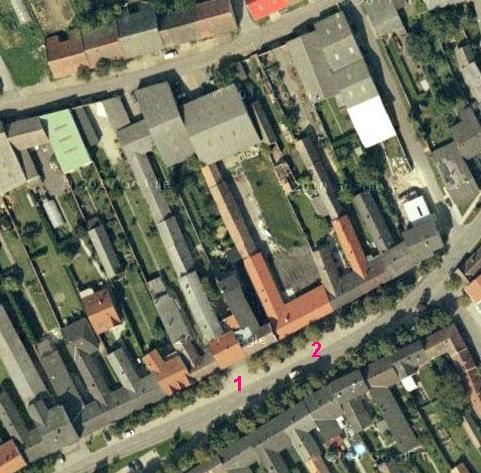 To
the right, is a satellite photo of a small part of central Wallern (in the Neusiedl district
of Burgenland). It shows part of the same street, Hauptstrasse, pictured in the photos above.
In the satellite photo, you can see an example (marked with a red "1") of the typical very
deep, very narrow lot—with its courtyard defined by the property's buildings and the
neighbor's buildings. The property marked with a red "2" is apparently, a double lot...
presumably of more modern vintage. To
the right, is a satellite photo of a small part of central Wallern (in the Neusiedl district
of Burgenland). It shows part of the same street, Hauptstrasse, pictured in the photos above.
In the satellite photo, you can see an example (marked with a red "1") of the typical very
deep, very narrow lot—with its courtyard defined by the property's buildings and the
neighbor's buildings. The property marked with a red "2" is apparently, a double lot...
presumably of more modern vintage. Many of the houses no longer have the full row of buildings down the length of the property; instead, a tall fence serves to define the property line (an example of such is the lot between the properties marked "1" and "2"). This basic form is not a modern phenomenon... in the old days, the "Tor" (gate), "Hof" (yard) and the many buildings were functional parts of working farmsteads and their structure provided security from thieves and other villains plus convenience for the owner. 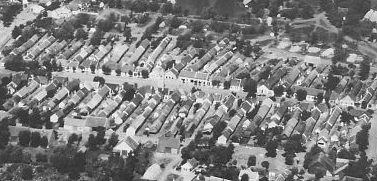 To
the right, is an aerial photo of Wallern from the 1930s. Again, the central street in the
image, Hauptstrasse, is the same as in the above photos (with the satellite photo being of
buildings located to the right of center on the far side of the street). In this 80-year-old
photo, we see that almost every farmstead followed the basic form: a deep, narrow lot with
buildings stretching along the side of the Hof and many having a large barn or shed at the
back closing off the property. To
the right, is an aerial photo of Wallern from the 1930s. Again, the central street in the
image, Hauptstrasse, is the same as in the above photos (with the satellite photo being of
buildings located to the right of center on the far side of the street). In this 80-year-old
photo, we see that almost every farmstead followed the basic form: a deep, narrow lot with
buildings stretching along the side of the Hof and many having a large barn or shed at the
back closing off the property. This consistency of form peeked my curiosity, so I investigated further. It turns out that large parts of rural Austria can be characterized by the types of farm buildings found there. Not surprisingly, a rural farm compound usually served multiple purposes and, for each purpose, there was a separate building (or part of a building) that served that need. These needs included living spaces, barns for animal husbandry, stables for housing work animals, and sheds for storage of supplies and machinery. These highly-structured farm compounds are generally distinguished by their layout, and there are many names used to define them: Einhof (single-), Zwiehof (double-), Dreiseithof (three-side-), Vierseithof (four-side-), Mehrseithof (multi-sided-), Streckhof (stretch-), Hakenhof (hook-), Zwerchhof (transverse-), and Haufenhof (unplanned-) among them. The Streckhof, Hakenhof and Zwerchhof are variations of the Einhof. The predominant types of farm compounds in Burgenland are the Streckhof and Hakenhof; southern Burgenland also has the Dreiseithof and Vierseithof forms. These forms arise, in part, from the lay of the land and the nature of the villages. In the region around Lake Neusiedl and in the Lafnitz and Raab valleys, villages are either of linear type (built along the primary road) or built around a green; in southern Burgenland, villages are almost always of the linear type, but also with many scattered, small settlements. In the flat lands of Neusiedl or in the river valleys, the building of highly-structured, compact villages with standardized farm-compound layouts made sense. Where the land was irregular and more varied, the farm compounds had to adapt to take advantage of their individual space. In some cases, this consistency of form occurred because the village was planned and built according to the master design of the controlling nobility or government. The "Einhof" is characteristic of eastern Austria, particularly in the densely developed, regularly laid-out villages of the southeastern lowland regions (and is the dominant type shown in the pictures of Wallern above). 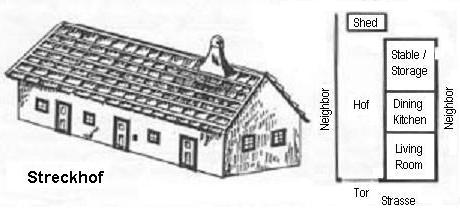 They
occur mainly in villages with long narrow building lots, although they also exist outside of
the villages. All the required units, living quarters, animal shelters and barns, are in a
single building under one roof, and connected to each other by passages. Access is either via
the front or the sides of the building. Generally these buildings have two floors. The ground
floor is often built of stone, the upper floor of wood. Only those located outside the
villages are built solely of wood (in southern Burgenland, of hardwood). They
occur mainly in villages with long narrow building lots, although they also exist outside of
the villages. All the required units, living quarters, animal shelters and barns, are in a
single building under one roof, and connected to each other by passages. Access is either via
the front or the sides of the building. Generally these buildings have two floors. The ground
floor is often built of stone, the upper floor of wood. Only those located outside the
villages are built solely of wood (in southern Burgenland, of hardwood).The variations of this form are the Streckhof, Hakenhof and Zwerchhof. When arranged in Streckhof form, the residential, stable and barn sections are in a line behind each other. The Hakenhof variation had the barn located crosswise, thus closing off the courtyard at the rear. The Zwerchhof is characterized by a cross-attached extension of the residential section on the street side,  often
added later on. often
added later on.Originally, the Hakenhof was one of the poorest types of expanded farms. Traditional, a pillars and arches covered walkway is used. The building material was unfired clay formed into bricks and dried in the air or mixed with soil and Ghack (chopped straw), and then made into a wall. It was also formed into square poles. Schab straw was used originally as roofing. Reeds and shingle coverage were less frequent. Because of the low strength of the mud walls, frequent fires and devastation caused by armed conflicts (being near the border), the building did not have long service expectations. Tiled roofs and stone and wood walls came later, spurred by the requirements of 19th Century fire insurance. 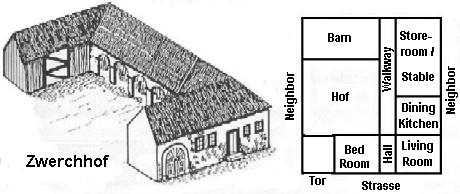 The most charming architecture feature of the house was the courtyard arbor, the so-called Trettner, situated lengthwise. It was often decorated with elaborate arches and arcades reminiscent of castles and monasteries. Living rooms often had a cover tram (beam) ceiling; the tram wood often had the name or initials of the owner and a date of construction. The Zwiehof, Dreiseithof, Vierseithof, Mehrseithof and Haufenhof forms are characteristic of the more mountainous regions of Austria. The most important Zwiehof type is the Paarhof (pair-), which can be found from Vorarlberg in Austria's west to its eastern Alpine foothills. 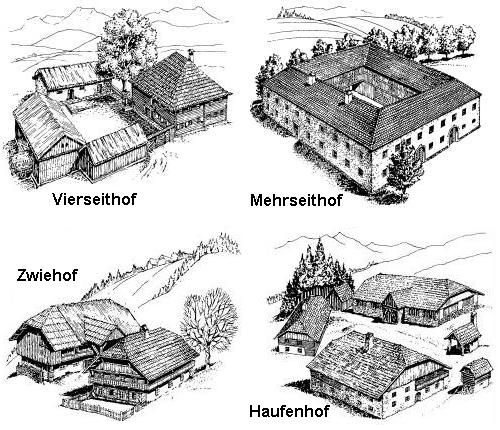 It
consists of two 2-story buildings, a living/storage house and a stall barn. Usually, their
roof ridges run parallel and their appearance is almost identical. The Haufenhof or Gruppenhof
(group-) type is characteristic of large parts of Carinthia and Styria as well as regions of
Upper and Lower Austria. These have a relatively large number of buildings of different sizes
arranged in a layout corresponding to the terrain. The various kinds of Mehrseithof, mostly
found in the non-alpine regions, range from very open to regular, castle-like forms and are
mostly built of stone. The Vierseithof in the Innviertel region is made up of 4 buildings
arranged around a courtyard in such a way that the corners of the yard are blocked off only by
gate walls or fences. While most Vierseithof types are at least partly built of stone, the
northern region of eastern Styria is characterized by a wooden type, occasionally also called
"Ringhof." It
consists of two 2-story buildings, a living/storage house and a stall barn. Usually, their
roof ridges run parallel and their appearance is almost identical. The Haufenhof or Gruppenhof
(group-) type is characteristic of large parts of Carinthia and Styria as well as regions of
Upper and Lower Austria. These have a relatively large number of buildings of different sizes
arranged in a layout corresponding to the terrain. The various kinds of Mehrseithof, mostly
found in the non-alpine regions, range from very open to regular, castle-like forms and are
mostly built of stone. The Vierseithof in the Innviertel region is made up of 4 buildings
arranged around a courtyard in such a way that the corners of the yard are blocked off only by
gate walls or fences. While most Vierseithof types are at least partly built of stone, the
northern region of eastern Styria is characterized by a wooden type, occasionally also called
"Ringhof."Of social interest are the so-called "Teilhof" (share-) buildings that resulted from the division of inheritances, which were usually found in built-up villages. The "Teilhof" is characterized by the fact that the parts of the building are used by several families. Most villages in the 1850s had a few double ownership, two-family, split homes; Mattersdorf had quite a few of, effectively, apartment buildings, especially among its Jewish residents. In practice, numerous mixed and transitional forms of these types of farm buildings exist, resulting from general historical developments and from the individual histories of alteration and extension of the buildings. (The pictures of Wallern at the top of this article show that extensions beyond the basic three or four "units" was common.) Not surprisingly, most farm houses built in the 20th century no longer correspond to traditional structures, having developed their own individual, more modern, forms (often similar to what we see in the US). Before we let this topic go, I'll note that Gerry Berghold wrote about Burgenland houses in both Newsletter 26 (on living conditions and other household issues) and in Newsletter 30 (on one of his ancestral homes, the Sauerzopf home in Stegersbach). I'll provide edited versions of each, as they add useful detail to the overall topic. NL 26: QUESTION CONCERNING DWELLINGS Margaret Kaiser wrote: "I also note that in most cases, brides and grooms resided in the groom's parents household. Does anyone know if each house number is really for a particular building or does it represent something else? At times, it seems to me that the house must have been truly filled to the walls with residents." Reply: The houses were filled to the walls. A roof and a place for a bed was all that was necessary for sleeping, but infant mortality was appalling. There were large families, but many children did not reach adulthood. Also primogeniture forced younger children to go elsewhere early (about age 12-14) for apprenticeship or servant jobs. The average house consisted of 3 rooms (Maria-Theresianische Kolonistenhaus), sometimes four (Josefinische Kolonistenhaus): (1) a bedroom (father, mother, baby, younger children) - one main bed, crib, truckle (trundle) bed(s), chests, table, chair, wardrobe, lamp; (2) a kitchen - was often main room (warmest), (grandparents slept here - truckle bed(s) plus more young children or just the girls), wall benches, table, wood stove, dry sink, chairs, chests, cabinets; (3) a pantry or workroom (don't know if anyone slept there, but why not?) and (4) on occasion, another chamber. In German, "Stube", "Küche", "Kammer". Of course there were variations on these themes. There were other buildings often attached to the main house - a barn (even in the village), for hay & animals - which could contain a bedroom for adolescent boys. (My grandfather Sorger spoke of sleeping in a room in their barn in Rosenberg with his brothers and two uncles). A covered porch often ran the length of the main house (sleeping place for boys in summer) connecting kitchen entrance with barn. Peppers and onions would be strung and braided and hung up to dry there. There were outer sheds (wagon shed, work shop, outhouse, etc.) - possible sleeping places for servants, if any. Often a wine and root cellar - probably too cold for sleeping. Even in the middle of a village, the houses were often more of a "farmstead" than just a house as we know it. House numbers (introduced in the 1840's) were assigned to individual farmsteads (house plus barn plus outbuildings, there may also be a wall and a large carriage gate. Buildings often enclosed a small court yard, (many paved today, but dirt years ago), the wagon was brought in at night and the gate locked. Wood would be bundled and stacked against an inner wall near the kitchen or under a roof overhang. During the time of governmental solicitation of settlers (reign of Maria Theresa and Josef II), the government drew up house and village plans to be used for new construction. These plans show basically what I've just described. The LDS has a microfiche of them (LDS 6001514, German Settlement in Transdanubia, "Die Siedlungen des 18. Jahrhunderts im mittleren Donautal-Siedlungsgeschichtlichte Grundlagen", Prof. T. Miller, Weimar, 1947). Some dwelling statistics: (from History of Vas County, 1898; Magyarorszag Varmegyéi és Városai Vasvarmegye, Sziklay és Borovszky - LDS1045430): Poppendorf - 108 dwellings, 805 German inhabitants (average 7.5/dwelling); Muhlgraben - 91 dwellings, 632 German inhabitants (7); Königsdorf - 204 dwellings, 1373 German inhabitants (6.7); Eltendorf - 136 dwellings, 934 German inhabitants (6.9); Szt. Miklos - 45 dwellings, 310 Germans (6.9). NL 30: MORE ON BURGENLAND HOUSES Albert [Schuch] sent me ... a photo of the Sauerzopf home in Stegersbach. The Sauerzopf house is one of the main types found in the Burgenland. Albert answers my questions: > When would you say the Sauerzopf house was built (early 1800's ?). I'd rather say late 1800's, although a Sauerzopf house has been there centuries earlier (at least since the 16th century), it just has been rebuilt or renovated constantly. > Does that large door (centered on the outer wall) open to a courtyard? I notice the chimney in the rear which must mean the kitchen is there. Could you describe the floor plan for me? Yes, there is a courtyard. This house is what is called a "Dreiseithof" (three side), meaning it has a front, rear, and left hand side, whereas the courtyard is open to the right hand side. It has not always been this way: the oldest part of the building is the left hand side. Originally there was just this side, the building was what is called a "Streckhof" (built in a straight line). Most old Burgenland houses were built this way, all with the same floor plan: "Vorderstuben" (front room), "Kuchl" (kitchen), "Hinterstuben" (rear room), stable, barn. When my mother grew up (she was born 1932) the house was already a Dreiseithof. The front consisted (apart from the "Vorderstuben") of the entrance and one room at the right hand side of the entrance. The rear included stables for hens and pigs etc., was mainly timber construction. My mother, her sister and mother slept in the Vorderstuben, father in the Hinterstuben, and the (4) brothers in the room at the right hand side of the entrance. The attic was used to store corn, flour etc. |
||||||
9) MEMBER RESEARCH: SEARCHING FOR "HOME" We received a couple of new member applications this past month where the new member was largely "in the dark" concerning the European emigrant village of their ancestor. In one case, I believe the BB staff was able to discover the appropriate village; in the other case, we provided additional information and research ideas but were not successful in pointing the member at a particular village nor even whether the research should be directed toward Burgenland. For our "successful" response, Joyce Thomas Ward of La Mirada, CA, wrote to say: "I'm putting together a family tree for my children. Their father was Frank Paul Tomasits (which he changed to Thomas). He was born April 1929. His father was a first generation American, Frank Paul Tomasits, born 1903 in Pittsburgh, PA. The information I have on his parents is... Frank Paul Tomasits, born in Austria, 1877, wife was Josephine Tomasits from Germany, born 1880, they immigrated to the USA in 1899. Frank also had a brother Josef that immigrated a few years later. They lived in Pittsburgh, PA and attended St. Michael's Catholic church. If there is any way I can get more information on them, please let me know." This earned our somewhat "standard" introductory response and then a few pointers for research... "The only way to get more information is to do research. The BB is an mainly information exchange among members. Though we do have a small repository of information, we do not keep family trees. Looking at our Surnames pages, I see we have two members interested in the Tomasits name... I suggest you try to contact them. Unfortunately, the one who seems most likely to know something about your line (Jim Tomasits) does not have current contact information. You will need to try to find him via other sources. There is a Jim Tomasits in NC who came from Pittsburgh, but whether he is the one from our website listing is unknown. Here is his contact info: [redacted for privacy reasons]. Jim's info suggests that your Tomasits may have come from Vas-Szent-Mihály, Hungary (German name: Raab-Sankt-Michael). That would have been part of the Austro-Hungarian Empire until its 1921 dissolution. It is within a mile or so of the current Austrian (Burgenland) border. I also pulled the 1910 and 1920 census information for Frank (see below). I also found what I think is brother Josef's 1920 record (living less than a mile away from Frank). Josef is the one who claims Austria... but I never put much trust in "Germany" in census records... too often, if they spoke German, they were presumed (incorrectly) to be from Germany. While I don't know, I'd guess that Tomasits is Croatian (perhaps one of the other BB staffers will confirm or deny this). There are microfilms of the Vas-Szent-Mihály Catholic church records available from the LDS. Here is that info: [redacted for space reasons]. Film 602076 is the baptismal records for the time period of interest to you. 602077 is marriage records, presuming you find Frank and Joe in the baptismal records. 1910 Pennsylvania Census: Name: Frank Tomasito [the image clearly shows Tomasits, not Tomasito] Birthplace: Germany Relationship to Head of Household: Self Residence: Pittsburgh Ward 16, Allegheny, Pennsylvania Marital Status: Married Race : White Gender: Male Immigration Year: 1899 Father's Birthplace: Germany Mother's Birthplace: Germany Head Frank Tomasito M 33y Spouse Josephine Tomasito F 35y Child Paulina Tomasito F 9y Child Frank Tomasito M 7y Child Edward Tomasito M 5y Child Josephine Tomasito F 5y Child Irma Tomasito F 2y Child Maria Tomasito F y 9m 1920 Pennsylvania Census: Name: Frank Tomasite [the image clearly shows Tomasits, not Tomasite] Residence: , Allegheny, Pennsylvania Estimated Birth Year: 1877 Age: 43 Birthplace: Germany Relationship to Head of Household: Self Gender: Male Race: White Marital Status: Married Father's Birthplace: Germany Mother's Birthplace: Germany Head Frank Tomasite M 43y Spouse Josephine Tomasite F 47y Child Pauline Tomasite F 19y Child Frank Tomasite M 18y Child Edward Tomasite M 15y Child Josephine Tomasite F 15y Child Irma Tomasite F 12y Child Marie Tomasite F 10y Child Ferdinand Tomasite M 8y Joyce responded, saying: "Thank you for the information. I do know that Jim Tomasits is my (deceased) husband's nephew, but I have never met him. I will contact him to see what other information I can get. Thank you for your help." Klaus Gerger also provided some information and advice: "Here is some additional info on the Tomasits name. There are 2 Burgenland villages with Tomasits families in about 1857. St. Michael (Puszta Szent Mihaly, BB Member Sandra Wills refers to a Tomasits family from there) and Reinersdorf which is just over the border of Vasszentmihály. See: http://www.the-burgenland-bunch.org/HouseList/GS/StMichael.htm and: http://www.the-burgenland-bunch.org/HouseList/GS/Reinersdorf.htm. In Northern Burgenland you can find the name in Kittsee (spelled Tomaschitz), where the Austrian phonebook shows entries for Tomasits and Tomaschitz. You can see villages with current Tomaschitz/Tomasits names by searching on http://www.herold.at; use the second (blue) tab 'Telefonbuch' and enter Tomasi or Tomaschi into the name field (Wer, Was?) and Burgenland into the location (Wo?). Best regards, Likewise, Margaret Kaiser answered the request for help: Hello Joyce, Ancestry.com has a copy of Josef Tomasits' Petition for Naturalization. His occupation is listed as a brewer. He lived at 17 Monastary Avenue, Pittsburgh, PA. He was born 15 August 1883 in Ginisdorf, Hungary. Ginisdorf is the German name for Nemesmedves, Hungary. He came to the US on 17 April 1902, arriving in Baltimore on the vessel Hanover. His wife is Cecelia, born in Jakobshof, Austria. Two children are listed, Josephine, June 16 1905, and Anna Mary, April 8, 1907. This document was filed in December 1908. If this is the brother of the Frank you are researching, then it appears that Ginisdorf is the key to their birthplace. Microfilmed parish records, if Roman Catholic, are with Vas Szent-Mihaly; Lutheran are with Kukmirn. I may have (I am not certain) some of these records in my local Family History Center permanent collection. If you think this is your family, please advise and I will look for their birth entries on my next visit. Joyce responded, saying: "Hi Margaret, Thanks so much for the information. Yes, the family is the same. Frank and Josephine were married before they arrived in the USA in 1899. The family is of the Catholic faith and they went to St. Michael's on Pius St. in Pittsburgh. I'm am very grateful for this information from you and everyone else that responded in the Burgenland group." And then Margaret followed through with checking the church records: Vasszentmihaly Film No. 0602076 baptisms: • Jan 8, 1876, baptized Jan 8, Ferencz (Frank), born to Ferencz Tomasits and Fani Hessman • Aug 15, 1883, baptized Aug 16, Jozsef, born to Ferencz (Frank) Tomasits and Fani Hasman, Nemes Kismedves (Ginisdorf) house no. 14 Vasszentmihaly Film No. 0602077 marriages: • Jan 19, 1874, Franciscus Tomasits, age 28, and Francisca Hismann, age 16, both Roman Catholic, marry and reside at Nemes Kismedves house #14. His parents are Georgius? Tomasists and Maria Knasar. Her parents are Franciscus Hismann and Catharine Dömötor. (Note: There is a notation on this marriage record that bears research. It may be that the groom is originally from another place.) Looks like you will be searching the right trail (Ginisdorf/Nemes Kismedves). Our less successful response was to Edward Silver of Fort Gratiot, MI, who wrote to say: "Surname: SILVER". As you might imagine, this motivated another somewhat standard response: "Hi Edward, We require some indication that your ancestral name came from the Burgenland area. Clearly, if it did not, we are of no use to you and your membership does not benefit other members. Please provide some additional information so our membership can both benefit from you and have a chance to assist you. Ed responded honestly, saying: That's more than I've been able to find... Here are the names of my ancestry. Samuel Silver born 01-15-1879 somewhere in Austria. He came to the US around 1898. He was married to Jennie Silver (unknown maiden name) she was born sometime in 1881 also in Austria. They lived in San Fransisco had 3 kids then moved to Newark, New Jersey. Thanks" Ed, I did a little looking in records... found a lot... but nothing that ties Samuel to a particular place in Burgenland or even Austria. I've inserted in your text some information gleaned from the 1910 and 1920 censuses. Below that is more info from other sources. I suspect your best bet is to try to find Sam's naturalization record, which apparently would be San Francisco based. Alternatively, his NJ synagogue (unknown) might be a resource, or you might try to find the marriage record (again, San Fran, I'd presume). I've copied some of the other BB staff; perhaps they can expand on what I've found. The Silver name (or any obvious variation) does not appear in any of our BB records. This makes me think that it is unlikely he came from this area. However, I'll wait to see what the staff says before deciding whether to list you or not. -----Edited Original Message----- That's more than I've been able to find... Here are the names of my ancestry. Samuel Silver (Jewish/Hebrew) born 01-15-1879 somewhere in Austria. He came to the US around 1898 (per 1920 census, naturalized 1904) (1883 or 1893, per 1910 census). He was married (1902, per 1910 census) to Jennie Silver (Jewish/Hebrew, unknown maiden name) she was born sometime in 1881 in Russia (per 1910, 1920 censuses, came to US in 1898 per 1920 census; 1883 per 1910 census). They lived in San Fransisco (there in 1910) had 3 kids (Joel/George b1903-4, Eva b1906-7, David b1908-9 , per both censuses) then moved to Newark, New Jersey (there in 1920). ----------------------------------------------- United States, World War II Draft Registration Cards, 1942 Name: Samuel Silver Event Date: 1942 Event Place: Newark, Essex, New Jersey Residence: Newark, Essex, New Jersey Gender: Male Birth Date: 15 Jan 1879 Film Number: 2371754 Digital Folder Number: 4136097 Image Number: 01854 ----------------------------------------------- U.S. Social Security Death Index First Name: Samuel Last Name: Silver Birth Date: 15 January 1879 Social Security Number: 136-12-0873 Place of Issuance: New Jersey Last Residence: Essex, New Jersey Zip Code of Last Residence: 07052 Death Date: October 1970 Estimated Age at Death: 91 ----------------------------------------------- Cemetery Name: Talmud Torah Cemetery Address: 603 through 619 South Orange Avenue City / Country: Newark, NJ / USA Name: SILVER, Samuel Hebrew Name: Shmuel Date of Birth 1879 Date of Death: 10/31/1970 Father: Zoal Plot: Row02-#02L Name: SILVER, Jennie Hebrew Name: Zelda Date of Birth: 1885 Date of Death: 08/11/1959 Father: Hershel Plot: Row02-#01L Name: SILVER, Joel G. Date of Birth: 1904 Date of Death: 03/30/1940 Plot: Row02-#01L ----------------------------------------------- The following likely do not apply (but in one record, the guy had exactly the same name and birth date!): Rhode Island State Census, 1915 Name: Samuel Silver Residence: Providence Ward 03, E.D. 254, Providence, Rhode Island Age: 35 Estimated Birth Date: 1880 Place of Birth: Russia Relationship to Head of Household: Self Gender: Male Race: White Place of Birth: Father: Russia Place of Birth: Mother: Russia Page Number: N Line Number: 25 GSU Film Number: 1763988 ----------------------------------------------- Rhode Island, State Census, 1935 Name: Samuel Silver Event Date: 1935 Event Place: Providence, Rhode Island, United States Residence: 43 Eaton St, Providence, Providence, Rhode Island Street Address: 43 Eaton St Gender: Male Marital Status: Married Race: White Head of Household - Number in Family: 5 Birth Date: 15 Jan 1879 Birthplace: Russia Film Number: 1683631 ----------------------------------------------- New York, Eastern District Naturalization Petitions, 1865-1957 Name: Samuel Silver Event Date: 1904 Event Place: New York Nationality: Austria Birth Year: 1880 Arrival Year: 1884 Court: U.S. District Court, Brooklyn, Kings, New York Witnesses: Isador Silver NARA Publication Title: Index to Naturalization Petitions of the United States District Court for the Eastern District of New York, 1865-1957 NARA Publication Number: M1164 NARA Roll Number: 16 ----------------------------------------------- United States Census, 1900 Name: Sam Silver Residence: Fall River city, Bristol, Massachusetts Birth Date: Jan 1879 Birthplace: Russia Relationship to Head-of-Household: Father Birthplace: Russia Mother Birthplace: Russia Race or Color (expanded): White Head-of-household Name: Max Orvitz Gender: Male Immigration Year: 1897 Enumeration District: 0137 Sheet Number and Letter: 16B Household ID: 298 Reference Number: 61 GSU Film Number: 1240635 Image Number: 00000804 ----------------------------------------------- SSDI: Name Born Death Age Zip Zip Location) SS# (State & #) Silver, Jennie 01Jun1878 Feb1974 95 07071 Lyndhurst, NJ) NJ 146-42-8881 Silver, Jennie 26Jan1881 Apr1967 86 90036 Los Angeles, CA) CA 558-66-0788 Silver, Jennie 15May1885 Mar1965 79 New Jersey NJ 153-14-6520 Silver, Jennie 31Jun1883 Jun1973 89-90 08609 Trenton, NJ) NY 055-05-6439 Silver, Jessie 25Nov1887 Feb1980 92 07043 Montclair, NJ) NJ 142-54-7877 Silver, Jennie 22Feb1893 May1977 84 08203 Brigantine, NJ) PA 170-22-9140 Silver, Jennie 28Oct1908 13Dec1993 85 08817 Edison, NJ) NY 064-26-0679 |
||||||
10) HISTORICAL BB NEWSLETTER ARTICLES Editor: This is part of our occasional series designed to recycle interesting articles from the BB Newsletters of 10 years ago. This month, we provide one article, being predominantly a list of the districts of the city (and province) of Vienna, along with the former place names the districts include. If you can't seem to find that Austrian village your ancestors claim, you should consider whether it has now become part of Vienna. The list below should help. THE BURGENLAND BUNCH NEWS No. 95 April 30, 2001 DISTRICTS OF VIENNA (FORMERLY VILLAGES) Vienna, of course, is not part of Burgenland. It is a province all in itself—the leading city in an Empire which recognized three capitals: Vienna, Budapest and Prague. Surrounding villages were absorbed as the city expanded. Some village names changed or disappeared and others gave their names to today's districts. Many Burgenländers migrated to Vienna for work and we can find references to various districts in ancestral documents. Member Johannes Graf sends me the following: The Viennese Districts and the Residential Area Names. Format: Number. Name: Former Place Names (%, if split); [Unofficial Names] 1. Innere Stadt 2. Leopoldstadt: Leopoldstadt, Unterer Werd, Jägerzeile, Prater 3. Landstraße: Landstraße, Erdberg, Weißgerber; [St. Marx, Belvedere, am Modenapark] 4. Wieden: Wieden, Hungelbrunn, Schaumburgergrund 5. Margareten: Margareten, Nikolsdorf, Matzleinsdorf, Laurenzergrund, Reinprechtsdorf, Hundsturm 6. Mariahilf: Mariahilf, Gumpendorf, Magdalenengrund, Laimgrube, Windmühle 7. Neubau: St. Ulrich (90%), Neustift, Schottenfeld, Spittelberg, Laimgrube, Alt-Lerchenfeld (10%) 8. Josefstadt: Josefstadt, Strozzigrund, Breitenfeld, Alt-Lerchenfeld (90%), St. Ulrich (10%), Alservorstadt (10%) 9. Alsergrund: Alservorstadt (90%), Michelbeuern, Himmelpfortgrund, Li(e)chtental, Althan, Am Thury, Roßau 10. Favoriten: Favoriten, Oberlaa, Unterlaa, Rothneusiedl, Inzersdorf (50%); [Wienerberg, Laaer Berg] 11. Simmering: Simmering, [Kaiser-]Ebersdorf, Albern, Neu-Albern, Kledering (1%); [Simmeringer Haide] 12. Meidling: Meidling, Wilhelmsdorf, Gaudenzdorf, Altmannsdorf, Hetzendorf; [Am Schöpfwerk] 13. Hietzing: Hietzing, Unter St. Veit, Ober St. Veit, Hacking, Lainz, Speising; [Schöönbrunn, Friedensstadt, Roter Berg] 14. Penzing: Penzing, Breitensee, Unter-Baumgarten, Ober-Baumgarten, Hütteldorf, Hadersdorf, Weidlingau, Hainbach, Hinterhainbach, Steinbach (50%); [Wolfersberg, Hüttelberg, Steinhof] 15. Rudolfsheim-Fünfhaus: Reindorf, Rustendorf, Braunhirschengrund, Fünfhaus, Neu-Fünfhaus, Sechshaus; [Auf der Schmelz] 16. Ottakring: Ottakring, Neulerchenfeld; [Wilhelminenberg] 17. Hernals: Hernals, Dornbach, Neuwaldegg 18. Währing: Währing, Weinhaus, Gersthof, Pötzleinsdorf; [Schafberg] 19. Döbling: Heiligenstadt, Ober-Döbling, Unter-Döbling, Nußdorf, Josefsdorf, Kahlenbergerdorf, Grinzing, Ober-Sievering, Unter-Sievering, Salmannsdorf, Neustift am Walde 20. Brigittenau: Brigittenau, Zwischenbrücken; [Am Sporn] 21. Floridsdorf: Floridsdorf, Jedlesee, Großjedlersdorf, Neujedlersdorf, Leopoldau, Donaufeld, Strebersdorf, Stammersdorf; [Mühlschüttel, Schwarzlackenau] 22. Donaustadt: Stadlau, Eßling, Kagran, Aspern, Hirschstetten, Kaisermühlen, Breitenlee, Süßenbrunn, Neueßling, Neukagran; [Gänsehäufel, Neuhaufen, Schafflerhof, Mühlau, Heustadlmais, Biberhaufen, Schierlinggrund] 23. Liesing: Liesing, Atzgersdorf, Mauer, Rodaun, Erlaa, Alt-Erlaa, Neu-Erlaa, Inzersdorf (50%), Kalksburg, Siebenhirten; [Kadoltsberg, Rosenhügel, Steinsee, Neustift oder Straßenhäuser, Neu-Steinhof] Bibliography: Stadtchronik Wien, 1986, Verlag Christian Brandstätter [Ed note: Below is a map to help you locate each district. Note that some prior places were either split between districts or were not fully incorporated into the province and city.] 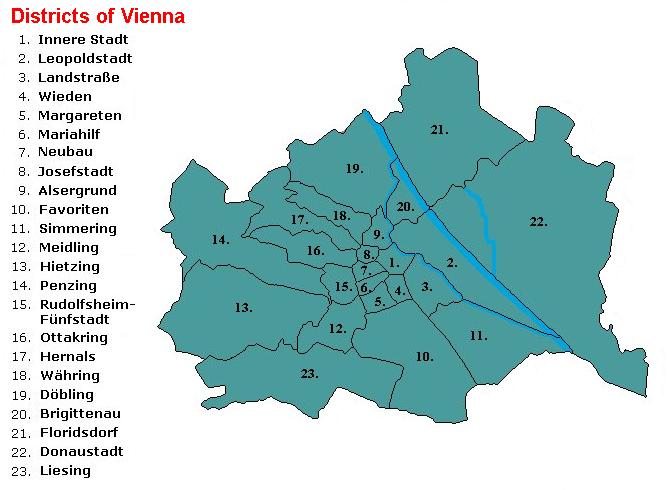 |
||||||
11) ETHNIC EVENTS LEHIGH VALLEY, PA (courtesy of Bob Strauch) Sunday, May 1, 2011: Annual Deutsches Maifest / German Ecumenical Worship Service at St. John's Lutheran Church in Reading. Special music by the Reading Liederkranz Chorus. Live radio broadcast over WEEU AM (www.weeu.com). Saturday, May 7, 2011: Maibaumtanz at the Coplay Sängerbund. Music by the Joe Weber Orchestra and mini-concerts by the Coplay Sängerbund Mixed Chorus and the Hianz'nchor. Saturday, May 7, 2011: 153rd Anniversary Concert of the Lehigh Sängerbund Chorus at Egner Memorial Chapel, Muhlenberg College, Allentown. Info: www.lehighsaengerbund.org Sunday, May 15, 2011: 38th Annual Viennese Ball at the Rodeway Inn in Allentown. Music by the Walt Groller Orchestra and the Valley Pops. Info: www.misacor-usa.org/index.php/see-all-latest-news-articles/1459-save-the-date-viennese-ball LANCASTER, PA (courtesy of Hannes Graf) Saturday, May 14, 7:30 - 11:30 pm: Maitanz. Lancaster Liederkranz, 722 S. Chiques Rd, Manheim, PA. $8 ($10 guest) at door or in advance at the bar. Music by Joe Kroboth. Dinner Service: 5:30-8pm. It is not necessary to attend the dance to enjoy Dietrich's Dance Night Menu. Seating is available in the Barroom for those not attending the dance. lancasterliederkranz@verizon.net, 717-898-8451 (after 4pm M-F). NEW BRITAIN, CT (courtesy of Margaret Kaiser) Friday, May 6, 7 pm: Heimat Abend (Home Evening) with Joe Rogers and his band. Austrian Donau Club (http://austriandonauclub.com/, 545 Arch Street). $3. (Kitchen special: Wursts) Note: Guitarist Peter Horst Frey, longstanding Heimat Abend entertainer, died. 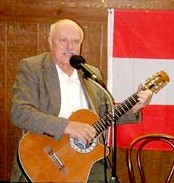 (In Memoriam, 1935 - 2011) Sunday, May 8, 8 am - 12 noon: Sonntag Frühstuck (Sunday Breakfast). Austrian Donau Club. Friday, May 20: Heurigan Abend ("A meeting where wine of the latest vintage is drunk") with Schachtelgebirger Musikanten (Box Mountain Musicians). Austrian Donau Club. $3. (Kitchen special: Sauerbraten). Tuesdays at 7 pm: Men's and Women's Singing Societies meet. Austrian Donau Club. Thursdays at 7 pm: Alpenland Tänzer (Alpine Country Dancers) meet. Austrian Donau Club. |
||||||
12) BURGENLAND EMIGRANT OBITUARIES (courtesy of Bob Strauch) Josefa Grossmann  Josefa
Grossmann, geb. Baldasty am 15 Juni 1922 aus Neuhaus in der Wart, gestorben am 17. März 2011
im 88. Lebensjahr in Woodside (Queens) / New York. Josefa
Grossmann, geb. Baldasty am 15 Juni 1922 aus Neuhaus in der Wart, gestorben am 17. März 2011
im 88. Lebensjahr in Woodside (Queens) / New York.Josefa Grossman, neé Baldasty, born June 15, 1922 in Neuhaus in der Wart, died March 17, 2011 in her 88th year of life in Woodside (Queens) / New York.
|
||||||
END OF NEWSLETTER |
||||||
NOTICE (Terms and Conditions): The Burgenland Bunch (BB) was formed and exists to assist Burgenland descendants in their research into their heritage and, toward that end, reserves the right to use any communication you have with us (email, letter, phone conversation, etc.) as part of our information exchange and educational research efforts. • If you do not want your communication to be used for this purpose, indicate that it is "confidential" and we will abide by that request. • Correspondents who communicate with the BB without requesting confidentiality retain their copyright but give a non-exclusive license to the BB allowing us to forward to BB members, publish in our monthly newsletter or on our website, and/or subsequently and permanently archive all or parts of such communications. The Burgenland Bunch homepage (website) can be found at: http://www.the-burgenland-bunch.org/ Burgenland Bunch Newsletter, copyright © 2011 by The Burgenland Bunch All rights reserved. Permission to copy excerpts granted if credit is provided. |
||||||
 News
News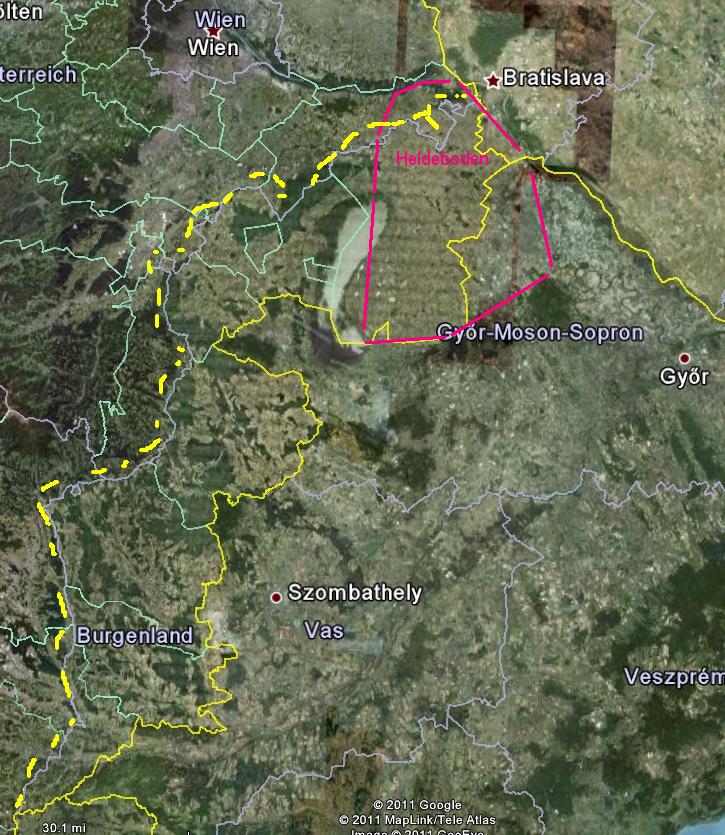 (or
even all of Burgenland) a part of it. Heideboden was actually quite small, encompassing only
~20 villages, and it and the villages were all in old Moson County.
(or
even all of Burgenland) a part of it. Heideboden was actually quite small, encompassing only
~20 villages, and it and the villages were all in old Moson County. 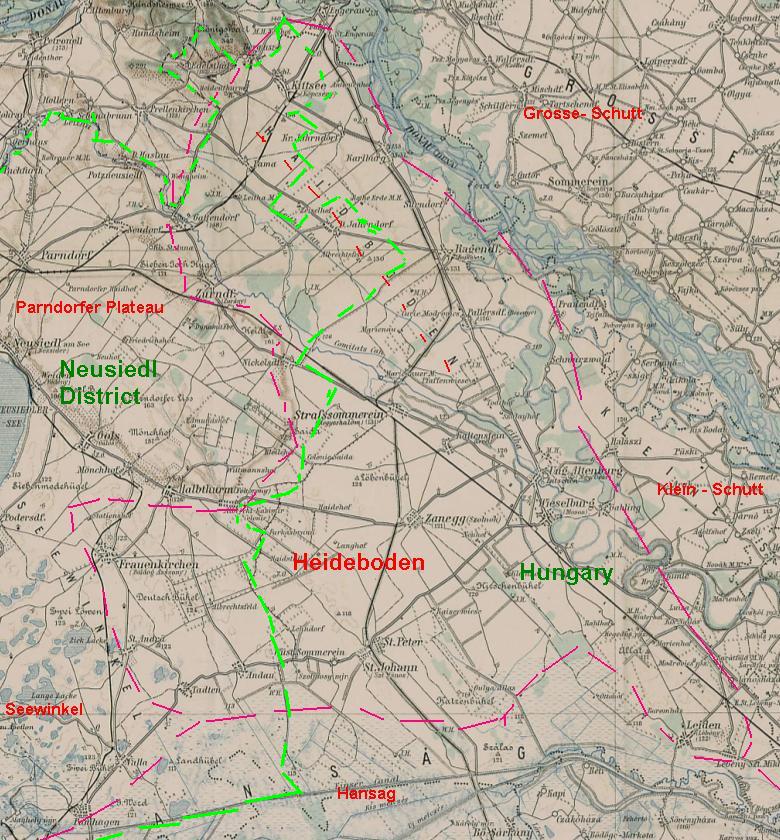
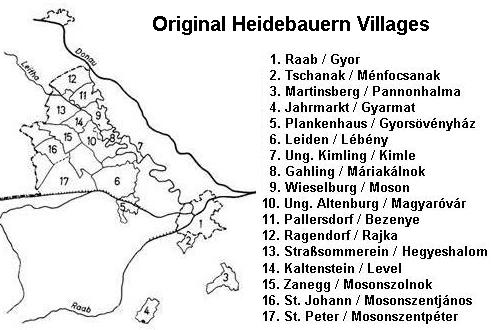 What
is immediately noticeable is that there are only 17 villages in Manherz's list and that
the first 5 are not in my list above; the other 12 are in my list and all are in
current-day Hungary (these are marked with an asterisk in my list).
What
is immediately noticeable is that there are only 17 villages in Manherz's list and that
the first 5 are not in my list above; the other 12 are in my list and all are in
current-day Hungary (these are marked with an asterisk in my list). 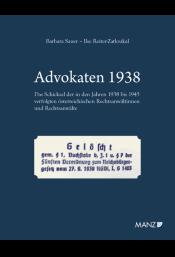 I
received today a large German language "coffee table" book entitled: ADVOKATEN 1938, Das
Schicksal der in den Jahren 1938 bis 1945 verfolgten Oesterreichischen Rechtsanwaeltinnen
und Rechtsanwaelte [LAWYERS IN 1938, The fate of persecuted female and male attorneys
in the years 1838 to 1945]. The book lists nearly 2000 persons. According to the
introduction, the Vienna, Lower Austria and Burgenland chambers listed on March 13, 1938,
2541 attorneys, while on Dec. 31, 1938, there were only 771 left, with a reduction on 1770.
I think most of those delisted were Jews. The book lists, in general, the name, date of
birth, when he or she received the "Doktorat", the address of the office and other
information such as emigration or deportation. In some cases pictures are included. I am
quite willing to look up someone on the list.
I
received today a large German language "coffee table" book entitled: ADVOKATEN 1938, Das
Schicksal der in den Jahren 1938 bis 1945 verfolgten Oesterreichischen Rechtsanwaeltinnen
und Rechtsanwaelte [LAWYERS IN 1938, The fate of persecuted female and male attorneys
in the years 1838 to 1945]. The book lists nearly 2000 persons. According to the
introduction, the Vienna, Lower Austria and Burgenland chambers listed on March 13, 1938,
2541 attorneys, while on Dec. 31, 1938, there were only 771 left, with a reduction on 1770.
I think most of those delisted were Jews. The book lists, in general, the name, date of
birth, when he or she received the "Doktorat", the address of the office and other
information such as emigration or deportation. In some cases pictures are included. I am
quite willing to look up someone on the list.